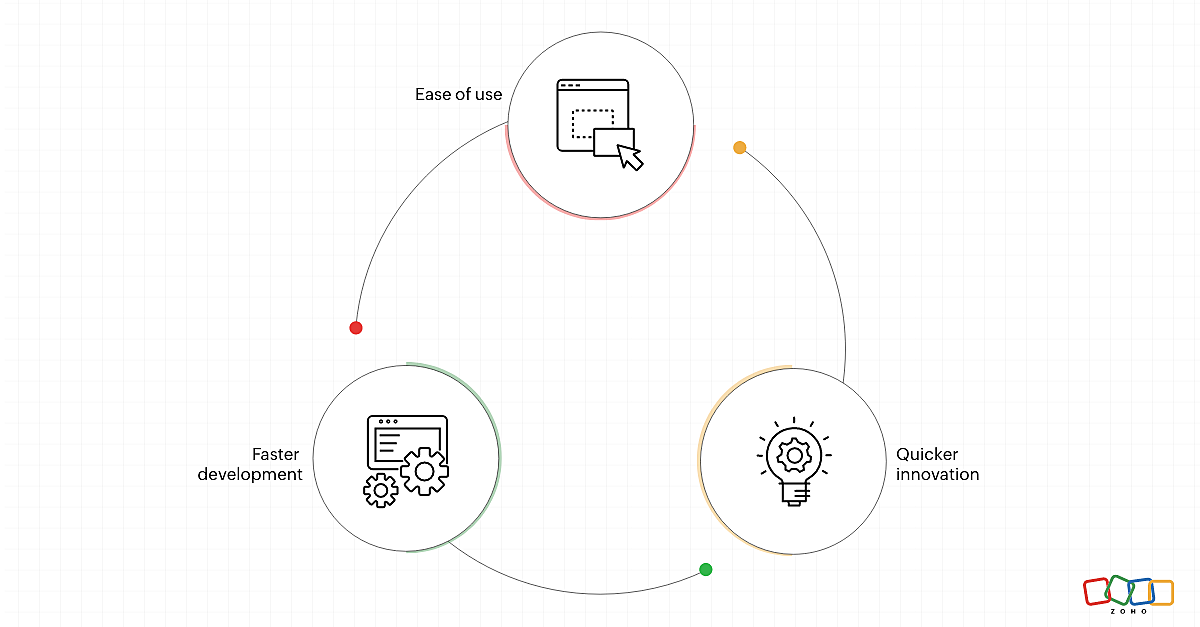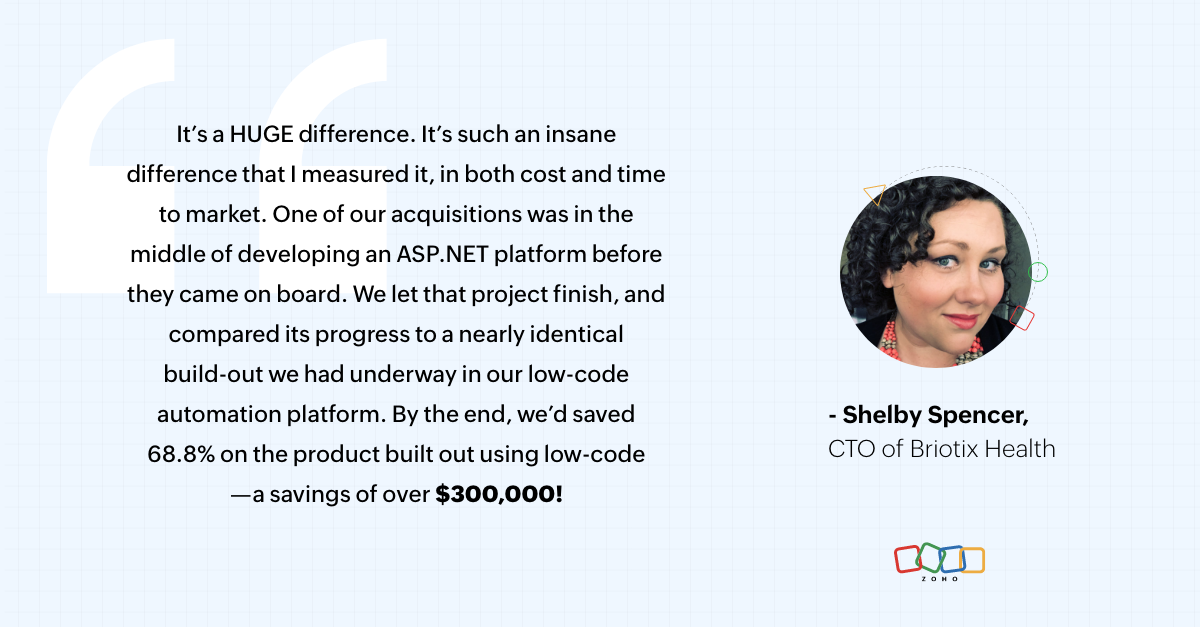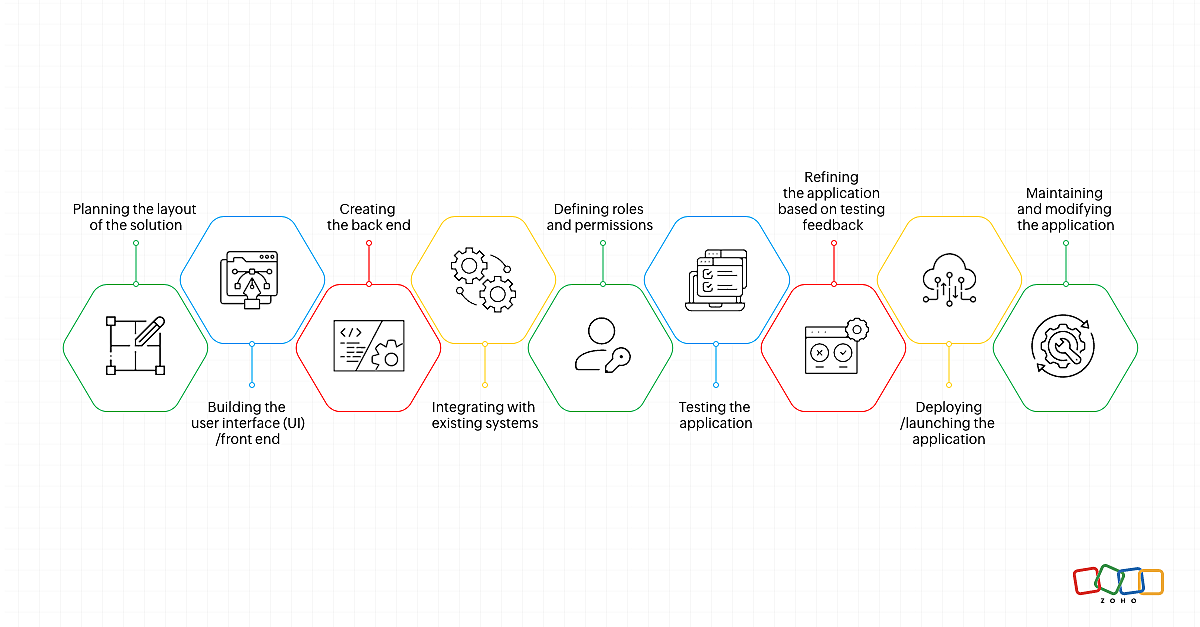- HOME
- Know Your Tech
- How low-code automation can save you time and money
How low-code automation can save you time and money
- Last Updated : July 23, 2025
- 1.3K Views
- 11 Min Read
In line with the positive trend associated with low-code technology since 2020, Gartner predicts that the low-code development technologies market will grow 20% in 2023. Adding to this, they also estimate that, by 2026, developers outside formal IT departments will account for at least 80 percent of the user base for low-code development tools—up from 60 percent in 2021. Based on the adoption trends witnessed in the past, there is a high probability that these estimates will soon be realized.
So, if you're not already aware of this technology and want a primer about low-code and how it contributes to accelerating business automation requirements across organizations, you've come to the right place. In this blog, we'll cover things ranging from the basic definition of low-code for automation to how it's helping real-life businesses transform the way they function.
Part 1 - Low-code automation explained
Low-code is a technology that lets you build custom applications faster and with fewer resources than coding from scratch. Users can drag and drop components and configure integrations, rather than writing every line of code themselves. It's faster and easier to put low-code applications together, and you don't need to be an expert to do it.
At the heart of this approach is the mission of masking the complexity involved in the app-building process.
Business automation simplified using a low-code platform
Low-code automation for businesses is an extension of the low-code movement. It's like using Legos to make computer programs that help with business tasks like finance, sales, and HR. Instead of building each brick by hand, you can use premade blocks that fit together easily to make your tower faster. This helps businesses save a substantial amount of time and money, because they don't have to hire as many developers—nor will they have to over-burden their existing ones. So, with low-code automation, businesses can do more things faster and more easily, saving time and money.
Part 2 - Low-code automation saves time and money
Using low-code automation tools for business process management can greatly benefit organizations, irrespective of their size. If you're a small business, the complexity of the automation that your process will require is naturally lower and hence easier to put together. On the other end of the spectrum, there are enterprise process automations that would need many intricate connections and workflows to meet the complexity and scale of the business.
What is common to both these cases is the need for automating business processes, and with minimal resources and time involved. Low-code technology gives businesses the best of both worlds (faster building with fewer resources) when it comes to automation requirements. How, you ask?
Speed of development:

Low-code automation platforms, thanks to their visual development environment, guided scripting, and prebuilt connectors, let your users drastically reduce the amount of time spent in the software development process. The time saved here is amplified, if you think about it—you save the time you would have spent on building a workflow automation the traditional way and you also save time because your team is now more productive.
Saving developer hours:

The ease of use of these platforms, which allow users/developers to build automation flows and apps faster, helps with saving time. If you're an enterprise that encourages your business users (non-tech employees) to take part in the process automation process, these benefits are two-fold. By enabling business users to build their own applications with IT oversight, your professional software developers can focus on more complex tasks, improving overall productivity.
A real-life beneficiary of low-code:

The ease of use of these platforms, which allow users/developers to build automation flows and apps faster, helps with saving time. If you're an enterprise that encourages your business users (non-tech employees) to take part in the process automation process, these benefits are two-fold. By enabling business users to build their own applications with IT oversight, your professional software developers can focus on more complex tasks, improving overall productivity.
Read their full low-code experience here.
Identifying the need for low-code automation
Reading success stories about low-code automation might make you feel like it's the ultimate solution for all businesses. But don't rush into it without evaluating your current needs and priorities. Take the time to evaluate the status quo before making any quick decisions. If you're trying to assess this, there are three scenarios you need to look at to ensure your effort is worth the time.
Outdated software systems:
When your existing software system is on its last leg, there are quite a few issues that you'll experience. Here's a list of common issues that will help you identify the need to look for a better system.
- One of the most obvious red flags is a dip in system performance that will, in turn, affect your business' productivity.
- Incompatibility with newer software or hardware is another sign that can spell the end of a system.
- As a system ages, the number of technical experts/developers who can support the system will also shrink and be more expensive to compensate. This makes keeping up the system a costly affair in the long run.
- The most critical issue is that of security. This might not be as obvious as the other issues mentioned before, but this has the potential to be the most dangerous, if it's not addressed well in advance. Older systems are vulnerable to security risks, making them a prime target for bad actors trying to gain unauthorized access.
You should also keep in mind that there might not be a need to completely scrap your system—you could also use a low-code automation platform to augment your current system's capabilities.

Mundane manual processes:
You've probably binged on the endless social media scroll at least once in your life. Mundane manual processes are, to some extent, similar to this phenomenon—you'll never realize the time you wasted until you step back and take a good look at it. Auditing your business processes is the first step when undertaking this endeavor.
Some of the best candidates for automation are processes that include repetitive, mundane tasks that are rule-based and transactional. This could be your email marketing process, a testing process, or an HR process.
Once you've identified these repetitive processes, you can either start with customizable ready-made templates or automate processes from scratch using a low-code platform.
Build vs enhance:
This scenario is an extension of the first one. Continuing to build on a system that has already reached its limits may not yield the desired results, making it necessary to scrap the current system and begin anew. While starting from scratch may not be the most ideal option, it can be the best choice for ensuring the long-term success of your business. In addition to security concerns, incompatibility, and performance issues...
- complexity of development/enhancement,
- lack of vendor support, and
- lack of documentation
...are signals that you should be looking for alternatives to your existing system.
Part 3 - Features that aid in the low-code automation journey
Now that we've covered the basics of low-code automation and how to determine if it's the right fit for your business, let's explore some of the key low-code platform features that make it possible.
Drag-and-drop interface for easy building:
Most low-code platforms use drag-and-drop interfaces to simplify the app building process. This can be used for a variety of tasks, from building user interfaces to connecting to external software. The extent to which a platform prioritizes ease of building will differ on who the product is designed for—there are pro-developer (more code, less no-code), pro-business user (less code, more no-code) and best of both world platforms (a good mix of code and no-code).
A library of prebuilt, customizable components:
Prebuilt components and applications that are fully customizable are other features to keep an eye on. These components can range from templates for HR forms to sales workflows and other business process-related pieces, which can be readily used or modeled to the bespoke automation requirements that your business is trying to address.
A unified business automation experience:
In the majority of cases, when a business app needs to be built, developers will have to work on different platforms to go from planning/modeling to deploying the application. The best low-code app development platforms unify and simplify these scattered steps. They bring together a plethora of layers in the app-building process.
If we were to make a list of these things, it could look something like:
- Planning the layout of the solution
- Building the user interface (UI)/front end
- Creating the back end
- Integrating with existing systems
- Defining roles and permissions
- Testing the application
- Refining the application based on testing feedback
- Deploying/launching the application
- Maintaining and modifying the application
A comprehensive low-code platform can streamline the development process and improve overall efficiency, making it a smart investment for your business.

Evaluating a platform for your low-code automation needs
Next up, let's explore how you can evaluate a low-code platform for your business process automation needs. To do this effectively, we'd advise you to strictly assess the need and readiness of your organization before spending time and resources on this step.
Define your requirement:
Once you identify the need for low-code automation at your organization, the first step is to map out your requirements clearly and get it reviewed by all stakeholders. This document should cover the list of processes/sub-processes that need to be automated, the specifics of what type of customizations are required, etc.
Finding the right platform:
After thoroughly documenting your requirements, the next thing to do is scour the market for low-code platforms that can help you achieve your present needs. While the list of capabilities to look for will depend on your specifics, the previous section can be a good starting point.
However, it's important to keep in mind that the right low-code development platform is not just the one with the technical capacity. It's also crucial to consider the platform's commitment to protect your privacy and provide best-of-breed technical support, on top of having a proven long-term product vision.
By taking a thorough and thoughtful approach to platform selection, you can choose a solution that will help your business succeed, both now and in the future.
Test out the platform:
Once you've shortlisted the platform, you'll need to test its real-life capabilities. If you can get this done on a free trial, that would be more economical. This could also be the best time to check out how good their help resources (guides, video tutorials, etc.) and technical support (even if this is limited by your free trial) are.
Check the future potential:
If you're satisfied with the initial assessment, you can start small by buying the pricing plan with the least investment required, to ensure the scalability and future potential of the platform. Most low-code platforms come with user-based pricing, so once you've identified a plan which comes with all the feature sets that you're looking for, you can start with one user and test it out.
Part 4 - Making the most of a low-code automation platform
Once you've evaluated and shortlisted the low-code platforms that you'll be using for your business automation needs, you can get into implementation. What approach you take in this venture will fully depend on the level of existing automation at your business.
 We've categorized businesses into four types, based on the degree of automation and complexity of their digital systems. Let's dive into these categories and explore the scope of low-code automation involved:
We've categorized businesses into four types, based on the degree of automation and complexity of their digital systems. Let's dive into these categories and explore the scope of low-code automation involved:
- Beginner type: This is a category that most newly set up businesses belong to, and is a mix of a low degree of automation and low implementation complexity. The scope for low-code-assisted automation in these businesses is huge, and it's also easier to get started, since there's no need to adapt to any existing software systems. You can start your automation journey by identifying the processes where the risk and resource utilization are minimal, and then scale from there as you find success.
- Chaotic type: There are cases where organizations might have much less automation set up, but the complexity of these implementations will be high, because of how these systems have been implemented. These implementations may also be muddled and lack proper documentation support. If you identify with this persona, then the first step that we suggest is for you to conduct an audit of your systems. At a high level, this would include visually mapping the current system, identifying the gaps, and creating documentation for it. Once this is sorted, you can start building on it or optimizing the system based on your audit's outcome.
- Radical type: An organization with this persona has done a good amount of automation, but none of it goes beyond a certain level of depth or complexity. The automation will mostly be at the surface level and constitute automating team-level notifications or communication. Similar to the chaotic type, you'll have to start by doing an audit of your systems and identify what processes can be improved by going beyond the basic levels of automation.
- Balanced type: If your organization has an implementation that permeates beyond the superficial automations and is spread out evenly amongst your business-critical processes, then your organization belongs to the balanced type. This means that what you've set up on the automation front is well-rounded. You can then use low-code development platforms simply to build on the good start that your business already has and extend your software systems further.
Low-code automation is industry and size agnostic
Whether you're an aviation business or a one-person professional service firm, a low-code development platform can be a game-changer for you. How useful low-code automation can be depends on how effectively you outline your business processes and identify your digital transformation opportunities. Most good low-code platforms focus on being compliant with data protection guidelines like GDPR for the EU or PIPEDA for Canada, and also industry-specific certifications like HIPAA for the health industry or PCI-DSS for credit card companies.
Based on the size of the business, it's advisable to have different strategies on how low-code is used. Let's take a deeper dive into the different strategies by organization size:
Low-code automation strategy for small businesses
If you're a small business opting for low-code software to automate your processes, you or other business users at your firm can start by learning the basics of the platform from help documentation or video tutorials. Most low-code platforms have a short learning curve and don't require much coding knowledge.
You can start by building small automation actions, like creating data collection forms or setting up email notification workflows. Once you/your team starts to get a handle on things, you can scale this to other processes. And if doing this is not something that you can focus on, considering your organization's priorities, you could always find an implementation specialist from the respective low-code solution's partner community.
Low-code automation strategy for medium-sized enterprises
Being a medium-sized enterprise, you'll probably have access to more resources, compared to a small business. If you have an in-house IT department, then the use of low-code platforms can greatly benefit developer productivity. But, if you don't have one, you'll have to adopt the same strategy as a small business—encouraging business users to develop or outsourcing the project to a low-code implementation specialist.
Low-code automation strategy for enterprises
Enterprises with access to a large pool of resources stand to gain the most by adopting low-code tools. If done right, the benefits of using low-code development platforms can be two-fold. The IT department stands to benefit from the 3-10X increase in developer productivity from using low-code tools—and the organization can also enable their business users to become citizen developers.
Note: Citizen developers are business users at an enterprise who build workflow apps for automating processes in their respective department or function.
Citizen development practice using low-code tools, when done right, will result in greater productivity throughout your enterprise:
- IT teams will start developing apps faster
- Citizen developers will reduce the load on IT teams, so they can focus on core software solutions
- This virtuous cycle of automation will result in an enterprise-wide productivity jump
Democratizing business process automation
Low-code software, and the applications that are built on it, can drastically help you save time and resources, regardless of the size of your business. It can also democratize business app development by reducing the complexity of the whole software development process.
Just remember: When evaluating and implementing low-code solutions, you have to be clear about what you are as a business and what kind of low-code platform suits your needs. This will depend on your existing technological infrastructure, the resources at your disposal and the urgency of the automation projects that you're planning. If you're interested in exploring more about low-code platforms in depth, you can check it out for free below.
 Rohith Krishnan S
Rohith Krishnan SRohith is a product marketer at Zoho. He writes about low-code, workflow automation and follows the latest digital transformation trends. Outside work he enjoys spending time with family, watching football matches and reading about futuristic trends, in no specific order.



